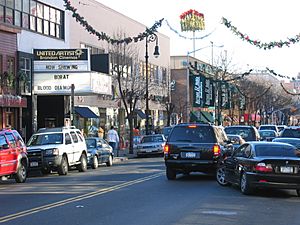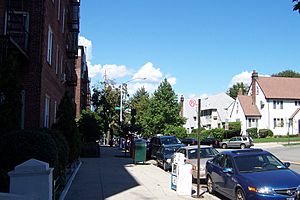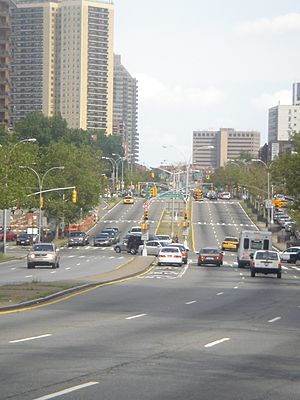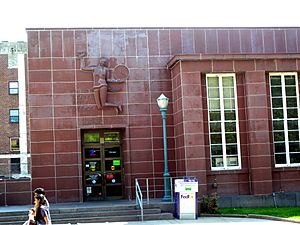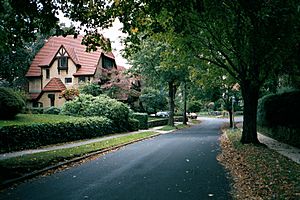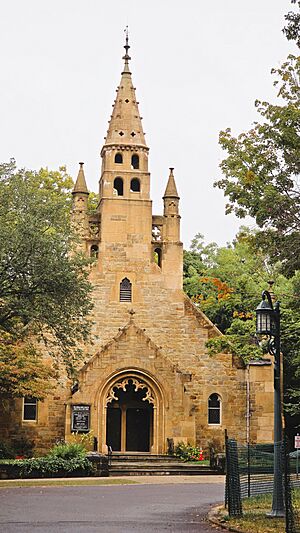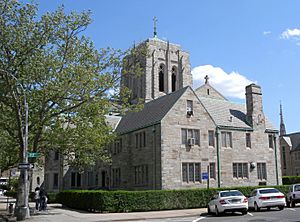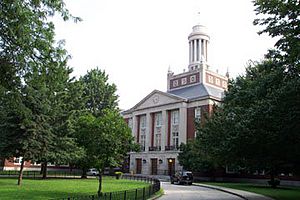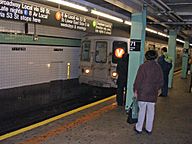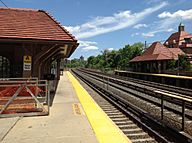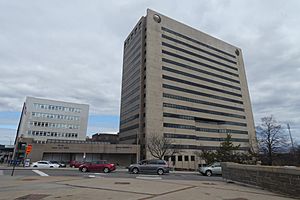Forest Hills, Queens facts for kids
Quick facts for kids
Forest Hills
|
|
|---|---|
|
Neighborhood
|
|
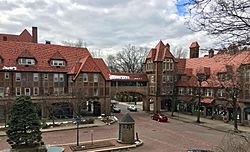
Station Square
|
|
| Country | |
| State | |
| City | New York City |
| County/Borough | Queens |
| Community District | Queens 6 |
| Area | |
| • Total | 7 km2 (2.6 sq mi) |
| • Land | 6 km2 (2.4 sq mi) |
| • Water | 0.5 km2 (0.2 sq mi) |
| Population
(2010)
|
|
| • Total | 83,728 |
| • Density | 13,470/km2 (34,886/sq mi) |
| Ethnicity | |
| • White | 58.3% |
| • Asian | 24.2% |
| • Hispanic | 12.4% |
| • Black | 2.5% |
| Time zone | UTC−5 (EST) |
| • Summer (DST) | UTC−4 (EDT) |
| ZIP Code |
11375
|
| Area codes | 718, 347, 929, and 917 |
Forest Hills is a neighborhood in the central part of Queens, a borough in New York City. It is next to Corona in the north and Rego Park in the west. To the south, you'll find Forest Park, and Flushing Meadows–Corona Park is to the east.
This area was first called "Whitepot." The name "Forest Hills" came from the Cord Meyer Development Company. They bought a large piece of land in 1906 and named it after nearby Forest Park. More buildings were added in the 1920s and 1930s. This happened as Queens Boulevard was made wider and the New York City Subway's Queens Boulevard Line opened.
Forest Hills is famous for tennis. The Forest Hills Stadium hosted the U.S. Open tennis tournament for many years, from 1915 to 1977. The West Side Tennis Club still offers grass courts for its members. The main shopping street, Austin Street, has many restaurants and stores.
Forest Hills is part of Queens Community District 6. Its ZIP Code is 11375. The New York City Police Department's 112th Precinct patrols the area.
Contents
- Exploring Forest Hills History
- Who Lives in Forest Hills?
- Homes and Buildings in Forest Hills
- Fun Places to Visit
- Staying Safe in Forest Hills
- Mail and ZIP Codes
- Learning in Forest Hills
- Getting Around Forest Hills
- Parks and Fun Places Outdoors
- Famous People from Forest Hills
- See also
- Images for kids
Exploring Forest Hills History
How Forest Hills Was Built
The development of Forest Park, a large park south of Forest Hills, began in 1895. A famous design company, Olmsted, Olmsted & Eliot, helped plan the park.
In 1906, the Cord Meyer Development Company bought about 600 acres of land. They renamed this area "Forest Hills" after Forest Park. Many single-family homes were built here. The roads in Forest Hills were finished by 1910. A street called Ascan Avenue is named after Ascan Bakus, one of the original farm owners.
In 1908, Margaret Sage, who started the Russell Sage Foundation, bought 142 acres from the Cord Meyer Company. This land became "Forest Hills Gardens," a special community in the southern part of Forest Hills. Grosvenor Atterbury, a well-known architect, designed Forest Hills Gardens. It was planned like the "garden communities" in England. It had its own inn, garage, and post office. The roads were narrow and winding to keep out through traffic. Many homes here have a Tudor style. These houses were mostly built between 1910 and 1917. They used a special method where parts of the houses were made in a factory and then put together on site.
The Long Island Rail Road opened a station in Forest Hills in 1911. Two years later, the Queens Boulevard trolley line opened. The LIRR station was built with a brick courtyard and a clock tower. These transportation options made Forest Hills a popular place to live.
Growing the Neighborhood
In 1914, the West Side Tennis Club moved to Forest Hills Gardens from Manhattan. They built the Forest Hills Tennis Stadium in 1923, which could hold about 13,000 people. The U.S. Open tennis tournament was held there until 1978. This made Forest Hills famous for tennis.
For a short time, Forest Hills also had a golf course. The Queens Valley Golf Club built a course in 1922, which opened in 1924. However, it closed in 1938 to make way for new homes.
Queens Boulevard was made wider in the 1920s. Plans for a subway line under Queens Boulevard also began. Developers bought land and built many new buildings, expecting the subway to arrive. Zoning rules changed to allow tall apartment buildings, making Forest Hills an even more desired place to live. The subway excavation started in 1931. Two subway stops in Forest Hills opened in 1936.
The number of people living in Forest Hills almost doubled in the late 1920s. It grew from 9,500 residents in 1927 to 18,207 residents three years later. By 1940, after the subway opened, the population reached 32,500. Building slowed down during World War II. After the war, empty lots in Forest Hills Gardens were developed. Some single-family houses were replaced with new apartment buildings.
Recent History of Forest Hills
In 1972, there was a disagreement about a proposed housing development called Forest Hills Houses. Some residents were concerned about how it would affect their community. Mario Cuomo, who later became the Governor of New York, helped to find a solution. The project's size was reduced.
During the 1970s and 1980s, Forest Hills became more diverse. People from different countries, like Iran, India, Israel, and the Soviet Union, moved to the neighborhood.
Who Lives in Forest Hills?
In 2010, the population of Forest Hills was 86,364 people. This was a small increase from the 85,046 people counted in 2000. The neighborhood covers about 2.6 square miles.
Most residents are White (58.3%), followed by Asian (24.2%). About 12.4% of the population is Hispanic or Latino. African Americans make up 2.5% of the residents.
The average life expectancy in Forest Hills and Rego Park is 85.4 years. This is higher than the average for New York City. Many residents are middle-aged or older adults.
In 2017, the average household income in this area was $75,447. About 16% of residents live in poverty, which is lower than the average for Queens and New York City. Most residents (62%) have a college education or higher.
Homes and Buildings in Forest Hills
The southern part of Forest Hills has many different types of homes. These include single-family houses, townhouses, and apartment buildings. South of the Long Island Rail Road, the Forest Hills Gardens area is a private community. It has some of the most expensive homes in Queens.
The Cord Meyer community is on the north side of Forest Hills. It has detached single-family homes. Many new, larger homes have been built here. The Bukharian Jewish community has moved to this area since the late 1990s. They often build bigger homes for their large families.
On the northwestern edge of Forest Hills, near the Long Island Expressway, is the Forest Hills Co-op Houses. This is a low-income housing project. Its construction in the 1970s caused some discussion among residents.
Forest Hills South is in the southeastern part of the neighborhood. It is a group of seven Georgian apartment buildings. They are built around a private English garden. These buildings were designed by Philip Birnbaum and built in 1939.
Many other apartment buildings were designed by Philip Birnbaum and Alfred Kaskel. These buildings often have large lobbies, courtyards with fountains, and curved brick terraces. Some well-known high-rise apartment buildings include the Continental, the Pinnacle, Parker Towers, and the Kennedy House.
Fun Places to Visit
Forest Hills was once the home of the U.S. Open tennis tournament. This big event was held at the West Side Tennis Club. It later moved to Flushing Meadows Park. When the Open was played here, people often just called it "Forest Hills."
The tennis stadium has also hosted many music concerts. Famous bands like The Beatles played there. In 2013, the stadium started hosting concerts again.
Austin Street is a busy and modern street. It has many shops, cafes, and restaurants. People from other neighborhoods visit Austin Street because of its charm.
There are two monuments in Forest Hills Gardens. One honors the victims of World War I. The other is a part of the Columbia yacht. This yacht won the America's Cup races in 1899 and 1901.
Several buildings in Forest Hills are listed on the National Register of Historic Places. These include The Church-in-the-Gardens, St. Luke's Episcopal Church, and the United States Post Office.
Staying Safe in Forest Hills
Forest Hills has a New York City Fire Department (FDNY) fire station. It is called Engine Co. 305/Ladder Co. 151 and is located on Queens Boulevard.
Mail and ZIP Codes
Forest Hills uses the ZIP Code 11375. The United States Post Office has two branches here. The Forest Hills Station is on Queens Boulevard. The Parkside Station is on Metropolitan Avenue.
Learning in Forest Hills
Forest Hills and Rego Park have many residents with college degrees. Most residents (62%) have a college education or higher. This is more than the average for New York City.
Students in elementary schools in Forest Hills and Rego Park miss fewer school days than the city average. Also, 91% of high school students here graduate on time.
Queens Community House offers free English classes for immigrants.
Schools for Kids and Teens
Public Elementary Schools
Forest Hills has several public elementary schools for grades PK–5:
- PS 101 School In The Gardens
- PS 144 Col. Jeromus Remsen School
- PS 174 William Sidney Mount
- PS 175 Lynn Gross Discovery School
- PS 196 Grand Central Parkway
- PS 220 Edward Mandel
- PS 303 The Academy for Excellence through the Arts (grades PK–4)
Public Middle Schools
The following public middle schools serve Forest Hills:
- JHS 157 Stephen A. Halsey (grades 6–9)
- MS 167 Metropolitan Expeditionary Learning School (grades 6–12)
- JHS 190 Russell Sage (grades 6–8)
Public High Schools
There are no zoned high schools in New York City. The high schools in Forest Hills for grades 9–12 are:
- Forest Hills High School
- Queens Metropolitan High School
Private Schools
Private schools in Forest Hills include two Catholic schools: Our Lady of Mercy and Our Lady Queen of Martyrs. The Kew-Forest School is an independent school. Yeshiva Gedolah Lubavitch, a Chabad high school, is also located here.
Colleges and Higher Education
Bramson ORT College used to have its main campus in Forest Hills. It closed in 2017. Touro College/NYSCAS has a branch in Forest Hills. Plaza College, which offers associate and bachelor's degrees, is also in Forest Hills.
Libraries for Reading and Study
The Queens Public Library has two branches in Forest Hills. The Forest Hills branch is on 71st Avenue. The North Forest Park branch is on Metropolitan Avenue.
Getting Around Forest Hills
Public Transportation Options
Many MTA Regional Bus Operations bus routes serve Forest Hills. These buses connect the neighborhood to other parts of Queens and Manhattan.
The New York City Subway has several stations in Forest Hills:
- 67th Avenue (M and R train)
- Forest Hills–71st Avenue (E, F <F>, M, and R trains)
- 75th Avenue (E, F <F> trains)
- Kew Gardens–Union Turnpike (E, F <F> trains)
The neighborhood also has a Long Island Rail Road commuter train station: the Forest Hills station. The Kew Gardens station is also nearby.
Main Roads
The main road is Queens Boulevard. It is a very wide street. Metropolitan Avenue is known for its antique shops. The heart of Forest Hills for shopping and dining is Austin Street. It stretches for about a mile between Yellowstone Boulevard and Ascan Avenue.
Parks and Fun Places Outdoors
Forest Hills is next to two of the largest parks in Queens. These are managed by the New York City Department of Parks and Recreation.
- Flushing Meadows–Corona Park is 1,255 acres. It hosted the World's Fairs in 1939 and 1964. It is home to the famous Unisphere.
- Forest Park is 544 acres.
Within Forest Hills, there are several parks and playgrounds:
- Yellowstone Municipal Park – Katzman Playground
- Annadale Playground
- Willow Lake Playground
- Ehrenreich-Austin Playground
- Russell Sage Playground
You can reach Flushing Meadows-Corona Park by walking over the Grand Central Parkway at several points.
Famous People from Forest Hills
- Awkwafina (born 1988), rapper and actress
- Hank Azaria (born 1964), actor and voice artist
- David Baltimore (born 1938), Nobel Prize-winning scientist
- Walter Becker (1950-2017), musician from Steely Dan
- Andrew Bergman (born 1945), screenwriter and director
- Jimmy Breslin (1929-2017), journalist
- Dale Carnegie (1888–1955), author of How to Win Friends and Influence People
- David Caruso (born 1956), actor
- John R. Dilworth (born 1963), animator, creator of Courage the Cowardly Dog
- Sergei Dovlatov (1941–1990), Russian writer
- Billy Eichner (born 1978), comedian and actor
- Geraldine Ferraro (1935–2011), former member of U.S. House of Representatives
- Art Garfunkel (born 1941), singer-songwriter
- Ernie Grunfeld (born 1955), former basketball player and general manager
- Steve Hofstetter (born 1979), comedian
- John Francis Hylan (1848–1936), former Mayor of New York City
- Donna Karan (born 1948), fashion designer
- Helen Keller (1880–1968), famous lecturer and activist
- Alan King (1927–2004), actor and comedian
- David Krumholtz (born 1978), actor
- Michael Landon (1936–1991), actor from Bonanza and Little House on the Prairie
- Jack Lew (born 1955), former United States Secretary of the Treasury
- Trygve Lie (1896–1968), first Secretary-General of the United Nations
- Carol Lynley (1942–2019), actress
- Chieli Minucci (born 1958), jazz musician
- Carroll O'Connor (1924–2001), actor, known as Archie Bunker
- Rick Overton (born 1954), actor and comedian
- Susan Polgar (born 1969), chess grandmaster
- The Ramones, a famous punk rock band:
- Dee Dee Ramone (1951–2002), bassist
- Joey Ramone (1951–2001), lead singer
- Johnny Ramone (1948–2004), guitarist
- Tommy Ramone (1952–2014), drummer
- Ray Romano (born 1957), actor-comedian, known for Everybody Loves Raymond
- Paul Simon (born 1941), singer-songwriter
- Fred Stone (1873–1959), actor
- Debbie Wasserman Schultz (born 1966), member of the U.S. House of Representatives
- Leslie West (1945–2020), musician from Mountain
- Anthony Weiner (born 1964), politician
- Pia Zadora (born 1954), actress
See also
 In Spanish: Forest Hills para niños
In Spanish: Forest Hills para niños
Images for kids


